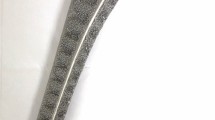Abstract
Purpose
Femoral component revision with either cemented or proximally coated stems has been disappointing, but revision with extensively coated stems has been promising. Our purpose was to evaluate the long-term outcome using an extensively hydroxyapatite (HA)-coated stem in femoral revisions surgery.
Methods
During 1988–1993 we performed 66 femoral revisions in 65 patients (49 women), mean age 58 (range, 28–86) years. We used a grit-blasted straight stem made of TiAl6V4 designed for press-fit insertion (Landos Corail; Landanger, Chaumont, France). In 48 hips we used primary stems of size 10 in two cases, size 11 in two, size 12 in seven, size 13 in four, size 14 in 12, size 15 in eight, size 16 in 12 and size 18 in one. In 18 cases, we used revision stems of size 12 in four cases, size 14 in seven, size 16 in five and size 18 in two.
Results
During follow-up, 21 patients have died. One patient had a traumatic fracture around the stem after six years, and another patient with osteoporosis developed fatigue fracture of the femoral bone after 22 years. In one patient the cup loosened after 23 years. The cup was revised, but deep infection occurred, and the patient underwent a two-stage revision of both components. Then, 12 of the revised stems were followed for more than ten years and 24 for more than 20 years. During this time only one stem was revised due to mechanical failure. This patient had a femoral defect classified to Type IV, and a proximal fracture occurred when the prosthesis was inserted. The fracture was stabilised by wires, but primary stability of the stem could not be obtained. At control examinations no patients suffered from significant thigh pain, and we noticed a low degree of proximal bone loss and a low incidence of distal bone hypertrophy.
Conclusions
Our study suggests that a fully HA-coated stem in femoral revision surgery can provide reliable results for up to 27 years. The bone changes confirmed a well-fixed femoral component with a rather physiological transfer of stress from proximal to distal regions with no significant thigh pain.


Similar content being viewed by others
References
Mulroy WF, Harris WH (1996) Revision total hip arthroplasty with use of so called second-generation cementing techniques for aseptic loosening of the femoral component. A fifteen-year-average follow-up study. J Bone Joint Surg Am 78:325–330
Malkani AL, Lewallen DG, Cabanela ME, Wallrichs SL (1996) Femoral component revision using an uncemented, proximally coated, long-stem prosthesis. J Arthroplasty 11:411–418
Mulliken BD, Rorabeck CH, Bourne RB (1996) Uncemented revision total hip arthroplasty: a 4-to-6-year review. Clin Orthop Relat Res 325:156–162
Krishnamurthy AB, MacDonald SJ, Paprosky WG (1997) 5- to 13-year follow-up study on cementless femoral components in revision surgery. J Arthroplasty 12:839–847
Moreland JR, Moreno MA (2001) Cementless femoral revision arthroplasty of the hip: minimum 5 years followup. Clin Orthop Relat Res 393:194–201
Paprosky WG, Weeden SH (2001) Extensively porous-coated stems in femoral revision arthroplasty. Orthopedics 24:871–872
Lawrence JM, Engh CA, Macalino GE (1993) Revision total hip arthroplasty: long term results without cement. Orthop Clin N Am 24:635–644
Crawford CH, Malkani AL, Incavo SJ, Morris HB, Krupp RJ, Baker D (2004) Femoral component revision using an extensively hydroxyapatite coated stem. J Arthroplasty 19:8–13
Makani A, Kim TW, Kamath AF, Garino JP, Lee GC (2014) Outcomes of long tapered hydroxyapatite-coated stems in revision total hip arthroplasty. J Arthroplasty 29:827–830
Sanli I, Arts JJC, Geurts J (2015) Clinical and radiologic outcomes of a fully hydroxyapatite-coated femoral revision stem: excessive stress shielding incidence and its consequences. J Arthroplasty 31:209–14, online 29 August
Malchau H, Kärrholm J, Xing Wang Y, Herberts P (1995) Accuracy of migration analysis in hip arthroplasty. Acta Orthop Scand 66:418–424
Gruen TA, McNeice GM, Amstutz HC (1997) “Modes of failure” of cemented stem-type femoral components: a radiographic analysis of loosening. Clin Orthop Relat Res 141:17–27
Engh CA, Bobyn JD, Glassman AH (1987) Porous-coated hip replacement; the factors governing bone in-growth, stress shielding and clinical results. J Bone Joint Surg (Br) 69:45–55
Zicat B, Engh CA, Gokcen E (1995) Patterns of osteolysis around total hip component inserted with and without cement. J Bone Joint Surg Am 77:432–439
Chen YL, Lin T, Shi MM, Hu B, Shi ZL, Yan SG (2015) Does hydroxyapatite coating have no effect over porous coating in primary total hip arthroplasty? A meta analysis. J Orthop Surg Res 10:21, online 28 January
Muir SW, Al-Ahaideb A, Huckell J (2011) Radiographic assessment of unemented total hip arthroplastyu: reliability of the Engh grading scale. Can J Surg 54:185–188
Hoberg M, Konrads C, Engelien J, Oschmann D, Holder M, Walcher M, Rudert M (2015) Outcome of a modular tapered uncemented titanium femoral stem in revision hip arthroplasty. Int Orthop 39:1709–1713
Coathup MJ, Blunn GW, Flynn N, Williams C, Thomas NP (2001) A comparison of bone remodeling around hydroxyapatite-coated, porous-coated and grit-blasted hip replacements retrieved at post-mortem. J Bone Joint Surg (Br) 83:118–123
Pidhorz LE, Urban RM, Jacobs JJ (1993) A quantitative study of bone and soft tissues in cementless porous-coated acetabular components retrieved at autopsy. J Arthroplasty 8:213–225
Roche O, Girard J, Canovas F, Migaud H, Bonnomet F, Goldschild M, Le Béguec P (2015) Assessment of fixation in cementless femoral revision of total hip arthroplasty: comparison of the Engh score versus radiolucent line measurement. Int Orthop. doi:10.1007/s00264-015-3024-z
Author information
Authors and Affiliations
Corresponding author
Ethics declarations
Funding source
No financing has been received for this study.
Conflicts of interest
The author declares that there are no conflicts of interest concerning this article.
Rights and permissions
About this article
Cite this article
Reikerås, O. Femoral revision surgery using a fully hydroxyapatite-coated stem: a cohort study of twenty two to twenty seven years. International Orthopaedics (SICOT) 41, 271–275 (2017). https://doi.org/10.1007/s00264-016-3204-5
Received:
Accepted:
Published:
Issue Date:
DOI: https://doi.org/10.1007/s00264-016-3204-5




